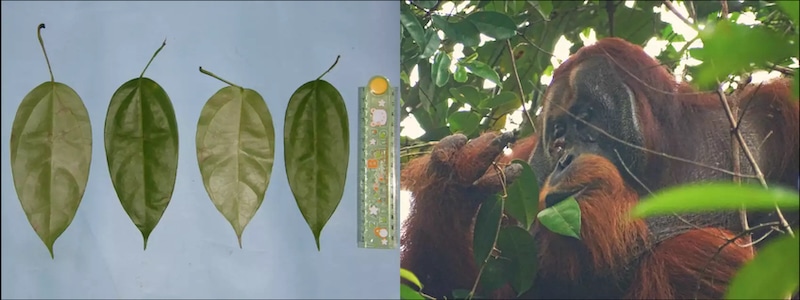
Biologists have observed a Sumatran male orangutan using the sap and chewed leaves of a medicinal plant to treat an open wound on his face.
While there has been previous evidence of self-medication behaviors in animals, it is the first known incident of an animal in the wild treating a wound with a “biologically active substance,” a press release from the Max Planck Institute of Animal Behavior said.
“During daily observations of the orangutans, we noticed that a male named Rakus had sustained a facial wound, most likely during a fight with a neighboring male,” said biologist Isabelle Laumer, the study’s lead author, in the press release.
The orangutan ate and applied sap numerous times from a climbing plant that had pain-relieving and anti-inflammatory properties. He also used the plant mesh to cover the entire gash on his face.
“Thus, medical wound treatment may have arisen in a common ancestor shared by humans and orangutans,” the press release said. “While sick and avoidance behavior can be regularly observed in non-human animals, self-medication in the form of ingestion of specific plant parts is widespread in animals but exhibited at low frequencies. The closest relatives to humans, the great apes, are known to ingest specific plants to treat parasite infection and to rub plant material on their skin to treat sore muscles.”
The study was conducted in Indonesia’s Suaq Balimbing protected rainforest, home to roughly 150 Sumatran orangutans, a critically endangered species.
Rakus carefully tore leaves from the Akar Kuning (Fibraurea tinctoria) or liana plant three days following his injury. He chewed the leaves and applied their juice repeatedly to the wound for several minutes, then covered the cut with the munched up leaves.
“This and related liana species that can be found in tropical forests of Southeast Asia are known for their analgesic and antipyretic effects and are used in traditional medicine to treat various diseases, such as malaria. Analyses of plant chemical compounds show the presence of furanoditerpenoids and protoberberine alkaloids, which are known to have antibacterial, anti-inflammatory, anti-fungal, antioxidant, and other biological activities of relevance to wound healing,” Laumer said in the press release.
The wound did not show signs of being infected after the injury and had closed after five days.
“Interestingly, Rakus also rested more than usual when being wounded. Sleep positively affects wound healing as growth hormone release, protein synthesis and cell division are increased during sleep,” Laumer added.
Rakus is believed to have been roughly 32 years old when he applied the wound treatment, reported NPR.
“The behavior of Rakus appeared to be intentional as he selectively treated his facial wound on his right flange, and no other body parts, with the plant juice. The behavior was also repeated several times, not only with the plant juice but also later with more solid plant material until the wound was fully covered. The entire process took a considerable amount of time,” Laumer said in the press release.
Senior author of the study Caroline Schuppli, an orangutan researcher, evolutionary biologist and conservationist, said it was possible that Suaq orangutans using the medicinal plant to treat their wounds came about “through individual innovation.”
“Orangutans at the site rarely eat the plant. However, individuals may accidentally touch their wounds while feeding on this plant and thus unintentionally apply the plant’s juice to their wounds. As Fibraurea tinctoria has potent analgesic effects, individuals may feel an immediate pain release, causing them to repeat the behavior several times,” Schuppli said.

Left: Pictures of Fibraurea tinctoria leaves. Right: Rakus feeding on Fibraurea tinctoria leaves (photo taken on the day after applying the plant mesh to the wound). Saidi Agam / Suaq Project
Because the wound treatment behavior had not been seen before, using Fibraurea tinctoria for this purpose may not have been previously used by Suaq orangutans. As with all the area’s adult males, Rakus’ birthplace is unknown, but he was not born there.
“Orangutan males disperse from their natal area during or after puberty over long distances to either establish a new home range in another area or are moving between other’s home ranges,” Schuppli explained in the press release. “Therefore, it is possible that the behavior is shown by more individuals in his natal population outside the Suaq research area.”
The active application of a biologically active substance for wound management by a great ape species brings new insight into self-medication in humans’ closest relatives, as well as wound medication’s evolutionary origins in general.
“The treatment of human wounds was most likely first mentioned in a medical manuscript that dates back to 2200 BC, which included cleaning, plastering, and bandaging of wounds with certain wound care substances,” Schuppli said. “As forms of active wound treatment are not just human, but can also be found in both African and Asian great apes, it is possible that there exists a common underlying mechanism for the recognition and application of substances with medical or functional properties to wounds and that our last common ancestor already showed similar forms of ointment behavior.”
Considered one of the World’s Top 25 Most Endangered Primate Species, there are only approximately 14,000 individual Sumatran orangutans left, according to the Sumatran Orangutan Conservation Programme.
The biggest threat to these highly intelligent, beautiful creatures is habitat loss due to the conversion of forests for the growing and harvesting of palm oil and other agricultural development.
The post Orangutan Observed Treating a Wound With a Medicinal Plant for the First Time appeared first on EcoWatch.
